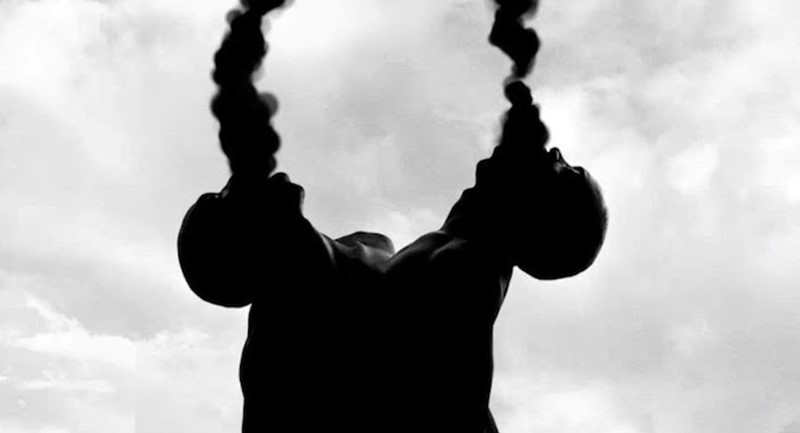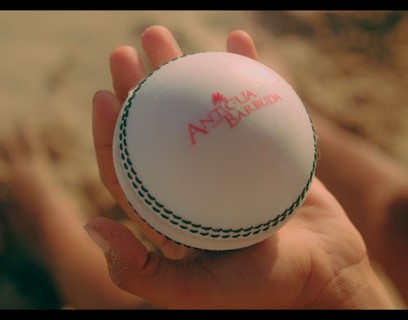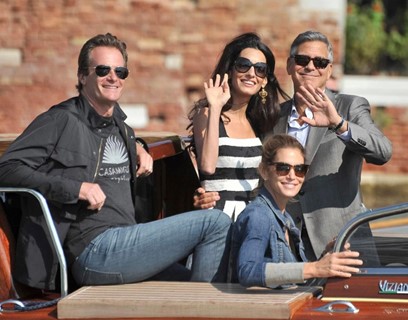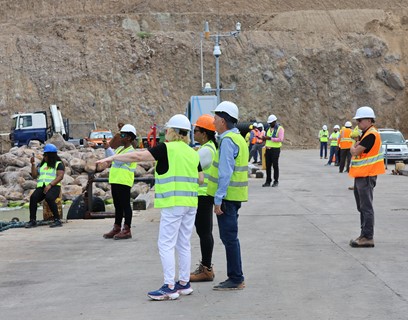
Clinton, NY – Senses of Time: Video and Film-Based Works of Africa – on view from September 10 to December 11, 2016 at the Wellin Museum of Art at Hamilton College – explores how time is experienced and produced by the human body. Figures stand, climb, dance, and dissolve in nine works of video and film art by seven acclaimed contemporary African artists: Sammy Baloji, Jim Chuchu, Theo Eshetu, Moataz Nasr, Berni Searle, Yinka Shonibare MBE, and Sue Williamson. Characters in these works, and the actions they depict, repeat, resist, and reverse the expectation that time must move relentlessly forward. Each work invites viewers to consider tensions between personal and political time, ritual and technological time, and bodily and mechanical time. Through pacing, sequencing, looping, layering, and mirroring, the works express and embody diverse perceptions of time.
Currently on view at the Smithsonian’s National Museum of African Art and the Los Angeles County Museum of Art (LACMA), Senses of Time will see its largest iteration yet when it opens at the Wellin in September. The exhibition will feature an expanded body of work and additional artists, including two videos by Kenyan artist Jim Chuchu and a new edition of Theo Eshetu’s installation created specifically for the Wellin’s show.
Tracy L. Adler, Director of the Ruth and Elmer Wellin Museum of Art, explains, “At the Wellin, Senses of Time will have a profound impact on the Hamilton College community. In the lead up to the exhibition, we have been working with faculty to integrate the exhibition into their coursework in a range of subjects and disciplines. Our close collaboration with the curators to make the Wellin’s iteration of the exhibition unique, and to create opportunities for Polly Roberts and Karen Milbourne to engage with the campus, is resulting in a stimulating dialogue around the social, personal, and political climate in Africa today. With its additional offerings and expansive interpretation of the exhibition, including a reflecting pool for Moataz Nasr’s work, the installation of the exhibition at the Wellin will be fresh and dynamic, allowing for new relationships between the works—as well as broader themes—to emerge.”
Jim Chuchu (b. 1982, Kenya), an artist whose work is exclusive to the Wellin’s presentation of the exhibition, will present Invocation: Severance of Ties and Invocation: Release, both created in 2015. These two single-channel projection videos played in succession explore the relationship between spiritual and cultural time – while one figure struggles to define himself in relation to his past, the other appears to accept who he has become both in the present and for the future. The two videos loop in a continuous negotiation of one generation after another’s struggle for self-definition in the context of the traditions and expectations into which they are born.
Similar themes around the strain between personal time and cultural legacies are explored in the works of Berni Searle (b. 1964, South Africa), Theo Eshetu (b. 1958, England) and Sue Williamson (b. 1941, England). In A Matter of Time (2003), Searle performs a riveting commentary on the slippages of time and identity as she attempts to walk across a transparent surface lubricated with olive oil – a tribute to her own “olive” skin. Despite the forward progression of the clock on Searle’s camera, the artist repeatedly glides forward only to get stuck and fall back again. Eshetu’s Brave New World III (2016) draws the viewer into a captivating kaleidoscopic space in which cultural images from the past, present, and future converge, while Williamson’s six-channel video projection, There’s Something I Must Tell You (2013), highlights the gaps between generations wrought by time, chronicling the struggle of six women who fought against apartheid in South Africa.
Moataz Nasr’s (b. 1961, Egypt) multimedia installation, The Water (2002), is a study on self and circumstance, revealing how time is tied closely to one’s identity. Concerned by the hardships of his fellow Egyptians under the government of Hosni Mubarak in the years leading up to the Arab Spring, Nasr spent six months filming the reflections of his compatriots in street puddles. The hold that these men, women, and children have on time appears tenuous: they materialize only briefly before a boot relentlessly stomps into the water. While this piece is typically displayed on a screen, at the Wellin the video will be projected onto an actual pool of water. As viewers peer into the pool, their reflections become a part of the fragmented and distorted imagery of the film itself, suggesting that we are all in flux as our circumstances outweigh our individual capacities to create stability.
Un Ballo Maschere (A Masked Ball) from 2004 by Yinka Shonibare MBE (b. 1962, England) interweaves and subverts the geographies and temporal assumptions that shape narratives of tradition and modernity. Drawing its name from a western opera about a Swedish king assassinated during wartime, the video stands as an allegory for the political hubris associated with the Iraq War. European ballroom dancers in sumptuous African-print cloth gowns dramatize the absurdities of political violence as history continues to repeats itself.
Sammy Baloji (b. 1978, Democratic Republic of the Congo) addresses the recoiling of time in a postcolonial nation-state in his single-channel video projection, Mémoire (Memory) from 2006. Grainy footage of mostly abandoned copper mines in the Democratic Republic of the Congo’s Katanga province and the soundtracks of political speeches provide the setting for Baloji’s commentary on the failed promises of past and present political leaders. The film’s backdrop of a deindustrialized wasteland is juxtaposed with the sinuous movements of the brilliant dancer and choreographer Faustin Linyekula, offering a close reading of how the body inserts itself into the rewriting of history and the reimagining of time.
Senses of Time is curated by Karen E. Milbourne, curator at the Smithsonian’s National Museum of African Art, and Mary “Polly” Nooter Roberts, professor in the Department of World Arts and Cultures/Dance at UCLA and consulting curator of African art at LACMA.
Programs / Events
SATURDAY, SEPTEMBER 10, 4 – 6 P.M.
Opening Reception
Senses of Time: Video and Film-Based Works of Africa
Organized by the Los Angeles County Museum of Art and the Smithsonian’s National Museum of African Art
Curated by Karen E. Milbourne, Curator, National Museum of African Art, Smithsonian Institution, and Mary (Polly) Nooter Roberts, Professor, Department of World Arts and Cultures/Dance, UCLA
TUESDAY, OCTOBER 18, 4:15 P.M.
Artists in Conversation: Berni Searle
Exhibition curator Karen Milbourne will lead a discussion with artist Berni Searle, whose work is on view in the current exhibition Senses of Time: Video and Film-Based Works of Africa. Co-sponsored by the Art History Department and made possible by support from The William G. Roehrick '34 Lecture Fund.


